The birth of social media platforms such as Twitter, Facebook, Instagram, etc., provided a unique new forum for communication that gave rise to an entirely new animal: digital influencers (Shiau W. et al. 2017). While these influencers pervade almost every industry, they have a notable presence in health/fitness/food and fashion/beauty businesses (Klasseen K et al. 2018) (Raggatt M. et al. 2018).
The sheer breadth of possible influencers makes it difficult for small businesses to pinpoint individuals that best correlate with their brand. Choosing an influencer that positively embodies the brand is crucial for a successful digital marketing campaign (Sokolova K. & Kefi H 2019).
This blog post delineates how best to approach this process, outlining the steps that small business owners should take when choosing which influencer will best promote the company’s desired image.
Step 1: The Target
Before searching for the perfect influencers, you must first determine how best to interact with the target audience by evaluating the profile of the desired customer. This can be done by analyzing customers’ most used social media platforms and any consumer preferences that pertain to your business’s unique product/service offering (Backaler 2018).
A great research tool to uncover these metrics is google trends, which allows you to search the most discussed online topics in different regions around the world.
Try it here
Step 2: The Main Goal
Next, determine what outcome you hope to achieve through the campaign. For reference, small retail brands typically seek to increase brand awareness and/or sales.
In regards to brand awareness, traditional word of mouth marketing has transformed into electronic word of mouth advertising that spreads to targeted audiences on much larger scales (Alalwan A. et al. 2017). Digital influencers epitomize this new realm of marketing as they can advertise to a mass amount of people that all fall under a specific niche/demographic.
Sunny Co Clothing company used this exact marketing strategy in 2017. The startup, which sells women’s bathing suits, created an Instagram campaign announcing free “Pamela” bathing suits for Instagram users who reposted the image below.
Rather than targeting mass audiences (macro influencers), the company targeted the niche group (nano influencers) of teenage girls to advertise their campaign.
The post was re-posted over 10,000 times and the company’s followers increased from 7,350 to 753,184 in one day! While they were unable to fill most orders, which caused a social media backlash, awareness of the brand increased and they were featured in publications such as Teen Vogue, Daily Mail, and TIME (Kelsey 2017).
Click here to view their Instagram page and here to see more of nano influencers through brand ambassadors.
After determining which niche market to target and which social media platform to use, you can then utilize your influencer marketing campaign to drive sales (Backaler 2018) .
Mason Jar Storage, which uses micro influencers on Pinterest to exemplify ways people can use their products, is a company that did just that. By enlisting the help of influencers who already have a following in categories like “do it yourself”, they integrated their product into the influencer’s established community while also creating one of their own.
Check out their Pinterest and use of influencers here
Step 3: The Influencer Search
Now you are ready to begin your influencer search.
Instagram and Twitter are excellent tools for finding influencers.
Instagram, for instance, offers the Search and Explore feature that allows you to look up hashtags and general topics that relate to your products.
Similarly, Twitter utilizes hashtags that you can tailor to address your topic
After finding your influencers, there are many ways to entice them to partner with your brand. For more information, check out my last blog post here.
Another great option for finding influencers is through platforms such as FameBit, BuzzStream, and Heepsy, which connect potential employers with viable influencers.
FameBit, for example, is perfect for small businesses because it is free to join for both the company and the influencer, only charging a 10% service fee once you and the influencer have agreed upon the publishing content. To use FameBit, your company must create a campaign and decide on social media platforms to use for the campaign (Famebit 2019)
(Salesbacker 2019)
You must also decide on a price to pay your influencers, the desired time frame for the campaign, and a photo of your product.
(Salesbacker 2019)
Influencers can then “bid” on the campaign by offering different prices and ideas for their service. FameBit enables you to learn about the influencers that have bid on your campaign and also offers a statistical analysis of their reach. Lastly, you pick and pay your desired influencers (Salesbacker 2019).
Hopefully this blog will help you start strategizing how to launch your own influencer marketing campaign!
This blog was done as a part of a digital marketing assignment by a student.
References
Alalwan A., Raana N., Dwivedi Y., Algharabat R. 2017. ‘Social media in marketing: A review and analysis of the existing literature’. Telematics and Informatics, vol 34, no 7, pp 1177-1190.
Backaler, J. 2018, Digital Influence: Unleash the Power of Influencer Marketing to Accelerate Your
Famebit. 2019. YouTube’s Branded Content Platform. YoutTube. [Online]. Available at: https://famebit.com/ [Accessed: 6 April 2019]
Kelsey J. (2017). ‘The Viral Sunny Co Clothing Instagram Giveaway Was Actually a Massive Success (And Not a Failure).’ Medium. 5th May. [Online]. Available from: https://medium.com/@justinkelsey/the-viral-sunny-co-clothing-instagram-giveaway-was-actually-a-massive-success-and-not-a-failure-327af68c590f [Accessed: 3 April 2019].
Klassen K., Borleis E., Brennan L., Reid M., McCaffrey T., Lim M. 2018. ‘What people “like”: analysis of social media strategies used by food industry brands, lifestyle brands, and health promotion organizations on facebook and instagram’. Med. Internet Res., vol. 20, no. 6 , pp. e10227
Raggatt M.,Wright C., Carrotte E., Jenkinson R., Mulgrew K., Prichard I., Lim M. 2018. ‘I aspire to look and feel healthy like the posts convey: engagement with fitness inspiration on social media and perceptions of its influence on health and wellbeing’. BMC Public Health, vol 18 no. 1, pp. 1002
Salesbacker. 2019. Salesbacker.com. [Online]. Available at: https://www.salesbacker.com/blog/64/A_Step_by_Step_Guide_to_Using_Famebit_in_Your_Advertising [Accessed: April 6 2019]
Shiau W., Dwivedi Y., Yang H. 2017. ‘Co-citation and cluster analyses of extant literature on social networks’. Int. J. Inf. Manag., vol. 37, no 5, pp. 390-399
Sokolova K., Kefi H. 2019, ‘Instagram and YouTube bloggers promote it, why should I buy?’ [online] Journal of Retailing and Consumer Services. Available at: https://doi.org/10.1016/j.jretconser.2019.01.011 [Accessed: 2 April, 2019]








